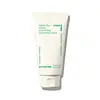What's inside
What's inside
 Key Ingredients
Key Ingredients

 Benefits
Benefits

 Concerns
Concerns

 Ingredients Side-by-side
Ingredients Side-by-side

Water
Skin ConditioningCoco-Betaine
CleansingCocamidopropyl Betaine
CleansingPolysorbate 20
EmulsifyingSodium Lauroyl Sarcosinate
CleansingSodium Chloride
MaskingDisodium Cocoyl Glutamate
CleansingInulin
Skin ConditioningCitric Acid
BufferingParfum
MaskingSodium Benzoate
MaskingSodium PEG-7 Olive Oil Carboxylate
EmulsifyingPropylene Glycol
HumectantLimonene
PerfumingPotassium Sorbate
PreservativeDisodium EDTA
Saccharomyces/Rice Ferment Filtrate
Skin ConditioningAlpha-Glucan Oligosaccharide
CleansingCamellia Sinensis Seed Oil
HumectantCandida Bombicola/Glucose/Methyl Rapeseedate Ferment
AntimicrobialAgave Americana Leaf Extract
Skin ConditioningSaccharomyces Cerevisiae Extract
Skin ConditioningLavandula Hybrida Grosso Herb Oil
PerfumingLinalool
PerfumingSodium Mangoamphoacetate
CleansingGeraniol
PerfumingCitrus Aurantium Amara Leaf/Twig Oil
MaskingButylene Glycol
HumectantCitral
PerfumingPhenoxyethanol
Preservative1,2-Hexanediol
Skin ConditioningGlycerin
HumectantBenzyl Alcohol
PerfumingLeuconostoc/Radish Root Ferment Filtrate
AntimicrobialCentella Asiatica Extract
CleansingLactobacillus/Soybean Ferment Extract
Skin ConditioningWater, Coco-Betaine, Cocamidopropyl Betaine, Polysorbate 20, Sodium Lauroyl Sarcosinate, Sodium Chloride, Disodium Cocoyl Glutamate, Inulin, Citric Acid, Parfum, Sodium Benzoate, Sodium PEG-7 Olive Oil Carboxylate, Propylene Glycol, Limonene, Potassium Sorbate, Disodium EDTA, Saccharomyces/Rice Ferment Filtrate, Alpha-Glucan Oligosaccharide, Camellia Sinensis Seed Oil, Candida Bombicola/Glucose/Methyl Rapeseedate Ferment, Agave Americana Leaf Extract, Saccharomyces Cerevisiae Extract, Lavandula Hybrida Grosso Herb Oil, Linalool, Sodium Mangoamphoacetate, Geraniol, Citrus Aurantium Amara Leaf/Twig Oil, Butylene Glycol, Citral, Phenoxyethanol, 1,2-Hexanediol, Glycerin, Benzyl Alcohol, Leuconostoc/Radish Root Ferment Filtrate, Centella Asiatica Extract, Lactobacillus/Soybean Ferment Extract
Water
Skin ConditioningGlycerin
HumectantMyristic Acid
CleansingLauric Acid
CleansingPotassium Hydroxide
BufferingStearic Acid
CleansingGlyceryl Stearate
EmollientGlycol Distearate
EmollientPalmitic Acid
EmollientLauryl Hydroxysultaine
CleansingPolyquaternium-22
Lauryl Glucoside
CleansingPropanediol
SolventParfum
MaskingPotassium Cocoyl Glycinate
1,2-Hexanediol
Skin ConditioningHydrolyzed Corn Starch
HumectantPinus Densiflora Leaf Extract
AntimicrobialDisodium EDTA
Butylene Glycol
HumectantArginine
MaskingAspartic Acid
MaskingGlutamic Acid
HumectantEthylhexylglycerin
Skin ConditioningCamellia Sinensis Leaf Extract
AntimicrobialAcrylates/Stearyl Methacrylate Copolymer
Emulsion StabilisingTremella Fuciformis Sporocarp Extract
AntioxidantTetrasodium EDTA
Hyaluronic Acid
HumectantXanthan Gum
EmulsifyingCeramide NP
Skin ConditioningAcorus Calamus Root Extract
PerfumingWater, Glycerin, Myristic Acid, Lauric Acid, Potassium Hydroxide, Stearic Acid, Glyceryl Stearate, Glycol Distearate, Palmitic Acid, Lauryl Hydroxysultaine, Polyquaternium-22, Lauryl Glucoside, Propanediol, Parfum, Potassium Cocoyl Glycinate, 1,2-Hexanediol, Hydrolyzed Corn Starch, Pinus Densiflora Leaf Extract, Disodium EDTA, Butylene Glycol, Arginine, Aspartic Acid, Glutamic Acid, Ethylhexylglycerin, Camellia Sinensis Leaf Extract, Acrylates/Stearyl Methacrylate Copolymer, Tremella Fuciformis Sporocarp Extract, Tetrasodium EDTA, Hyaluronic Acid, Xanthan Gum, Ceramide NP, Acorus Calamus Root Extract
 Reviews
Reviews

Ingredients Explained
These ingredients are found in both products.
Ingredients higher up in an ingredient list are typically present in a larger amount.
1,2-Hexanediol is a synthetic liquid and another multi-functional powerhouse.
It is a:
- Humectant, drawing moisture into the skin
- Emollient, helping to soften skin
- Solvent, dispersing and stabilizing formulas
- Preservative booster, enhancing the antimicrobial activity of other preservatives
Butylene Glycol (or BG) is used within cosmetic products for a few different reasons:
Overall, Butylene Glycol is a safe and well-rounded ingredient that works well with other ingredients.
Though this ingredient works well with most skin types, some people with sensitive skin may experience a reaction such as allergic rashes, closed comedones, or itchiness.
Learn more about Butylene GlycolDisodium EDTA plays a role in making products more stable by aiding other preservatives.
It is a chelating agent, meaning it neutralizes metal ions that may be found in a product.
Disodium EDTA is a salt of edetic acid and is found to be safe in cosmetic ingredients.
Learn more about Disodium EDTAGlycerin is already naturally found in your skin. It helps moisturize and protect your skin.
A study from 2016 found glycerin to be more effective as a humectant than AHAs and hyaluronic acid.
As a humectant, it helps the skin stay hydrated by pulling moisture to your skin. The low molecular weight of glycerin allows it to pull moisture into the deeper layers of your skin.
Hydrated skin improves your skin barrier; Your skin barrier helps protect against irritants and bacteria.
Glycerin has also been found to have antimicrobial and antiviral properties. Due to these properties, glycerin is often used in wound and burn treatments.
In cosmetics, glycerin is usually derived from plants such as soybean or palm. However, it can also be sourced from animals, such as tallow or animal fat.
This ingredient is organic, colorless, odorless, and non-toxic.
Glycerin is the name for this ingredient in American English. British English uses Glycerol/Glycerine.
Learn more about GlycerinParfum is a catch-all term for an ingredient or more that is used to give a scent to products.
Also called "fragrance", this ingredient can be a blend of hundreds of chemicals or plant oils. This means every product with "fragrance" or "parfum" in the ingredients list is a different mixture.
For instance, Habanolide is a proprietary trade name for a specific aroma chemical. When used as a fragrance ingredient in cosmetics, most aroma chemicals fall under the broad labeling category of “FRAGRANCE” or “PARFUM” according to EU and US regulations.
The term 'parfum' or 'fragrance' is not regulated in many countries. In many cases, it is up to the brand to define this term.
For instance, many brands choose to label themselves as "fragrance-free" because they are not using synthetic fragrances. However, their products may still contain ingredients such as essential oils that are considered a fragrance by INCI standards.
One example is Calendula flower extract. Calendula is an essential oil that still imparts a scent or 'fragrance'.
Depending on the blend, the ingredients in the mixture can cause allergies and sensitivities on the skin. Some ingredients that are known EU allergens include linalool and citronellol.
Parfum can also be used to mask or cover an unpleasant scent.
The bottom line is: not all fragrances/parfum/ingredients are created equally. If you are worried about fragrances, we recommend taking a closer look at an ingredient. And of course, we always recommend speaking with a professional.
Learn more about ParfumWater. It's the most common cosmetic ingredient of all. You'll usually see it at the top of ingredient lists, meaning that it makes up the largest part of the product.
So why is it so popular? Water most often acts as a solvent - this means that it helps dissolve other ingredients into the formulation.
You'll also recognize water as that liquid we all need to stay alive. If you see this, drink a glass of water. Stay hydrated!
Learn more about Water